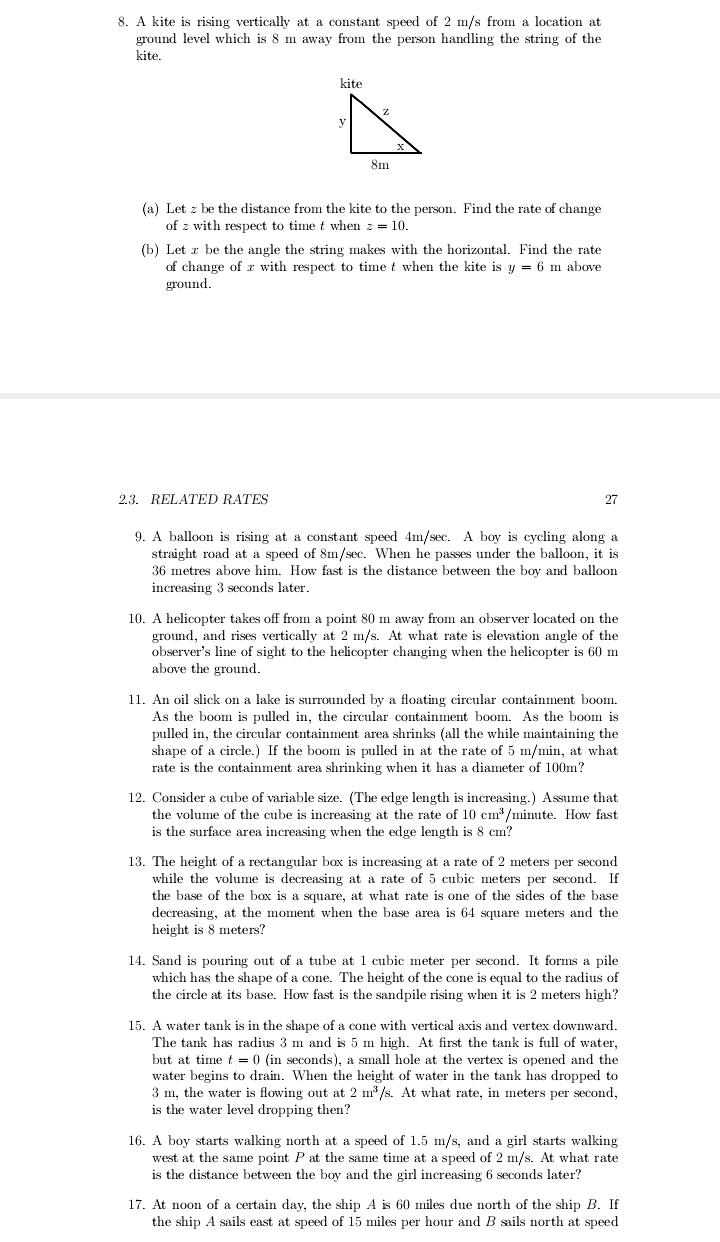
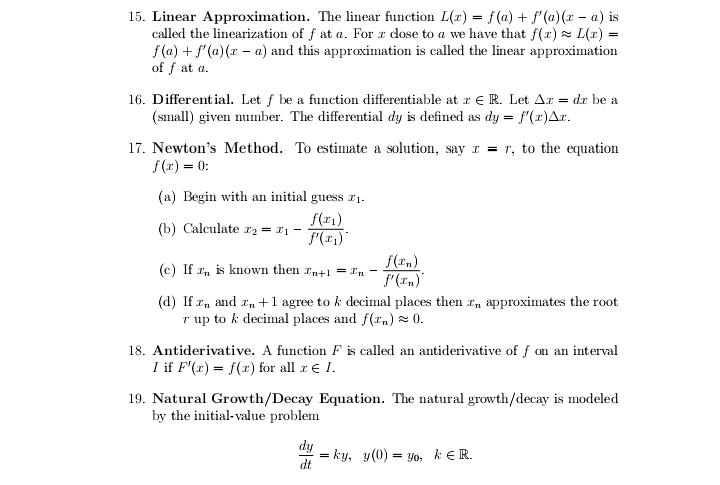
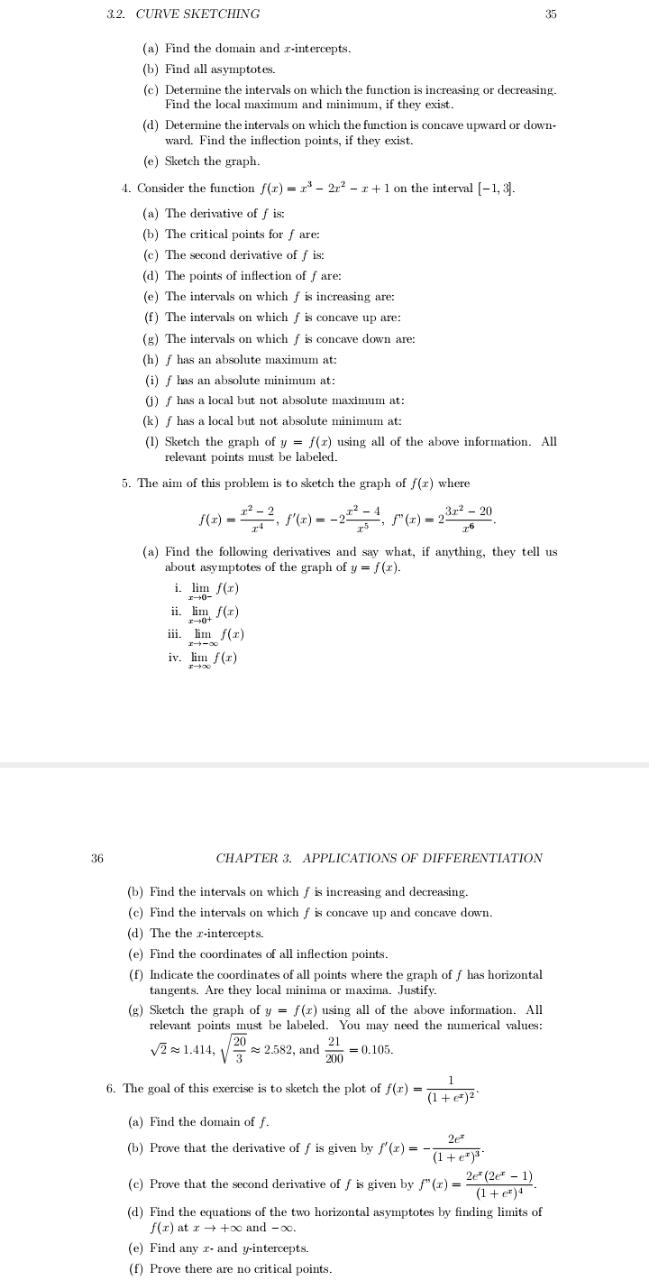
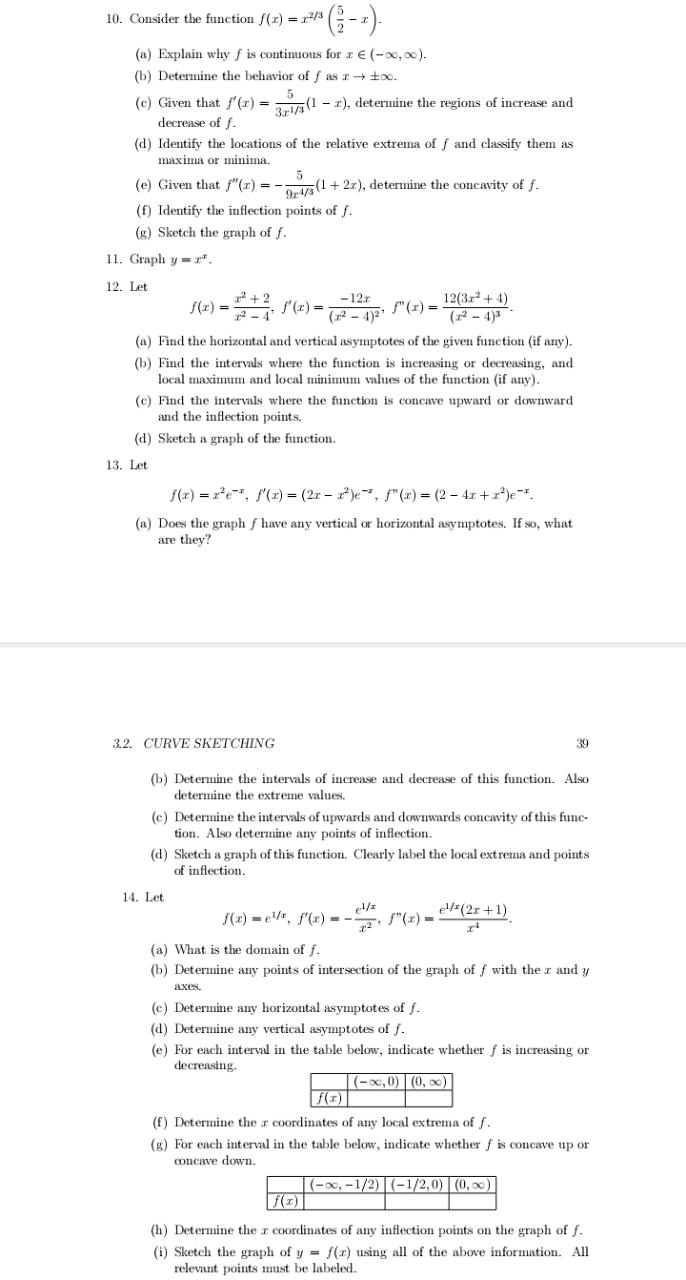
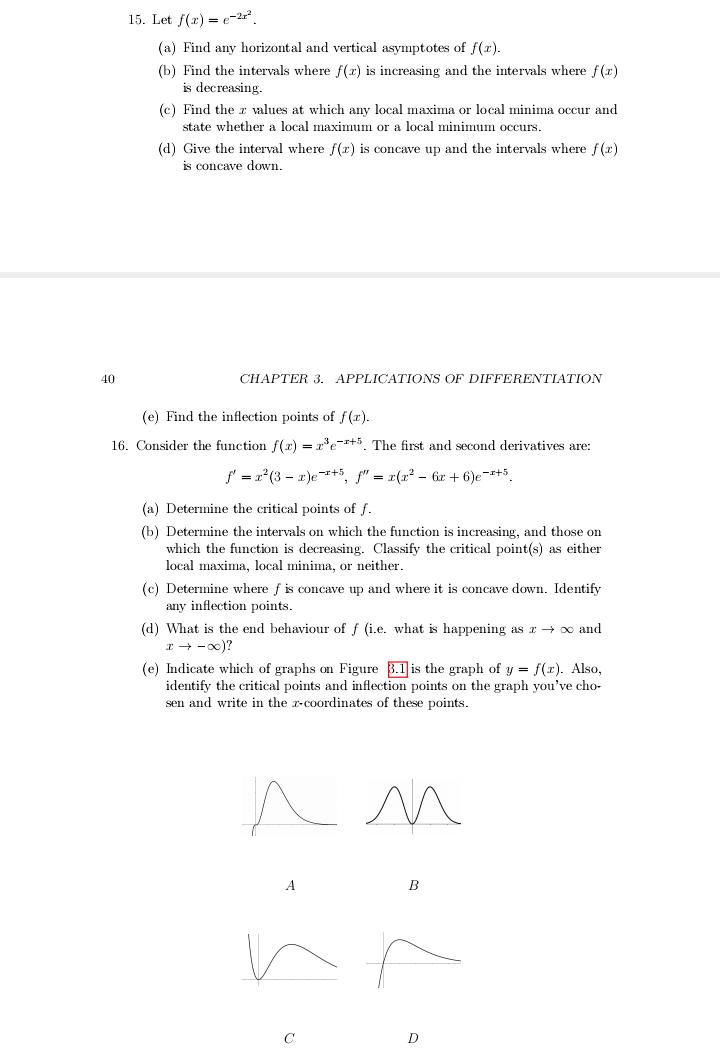
#detailed explanations plz.
8. A kite is rising vertically at a constant speed of 2 m/s from a location at ground level which is 8 m away from the person handling the string of the kite. kite V 8m (a) Let z be the distance from the kite to the person. Find the rate of change of z with respect to time t when z = 10. (b) Let z be the angle the string makes with the horizontal. Find the rate of change of r with respect to time t when the kite is y = 6 m above ground. 2.3. RELATED RATES 27 9. A balloon is rising at a constant speed 4m/sec. A boy is cycling along a straight road at a speed of 8m/sec. When he passes under the balloon, it is 36 metres above him. How fast is the distance between the boy and balloon increasing 3 seconds later. 10. A helicopter takes off from a point 80 m away from an observer located on the ground, and rises vertically at 2 m/s. At what rate is elevation angle of the observer's line of sight to the helicopter changing when the helicopter is 60 m above the ground. 11. An oil slick on a lake is surrounded by a floating circular containment boom. As the boom is pulled in, the circular containment boom. As the boom is pulled in, the circular containment area shrinks (all the while maintaining the shape of a circle.) If the boom is pulled in at the rate of 5 m/min, at what rate is the containment area shrinking when it has a diameter of 100m? 12. Consider a cube of variable size. (The edge length is increasing.) Assume that the volume of the cube is increasing at the rate of 10 cm /minute. How fast is the surface area increasing when the edge length is 8 cm? 13. The height of a rectangular box is increasing at a rate of 2 meters per second while the volume is decreasing at a rate of 5 cubic meters per second. If the base of the box is a square, at what rate is one of the sides of the base decreasing, at the moment when the base area is 64 square meters and the height is 8 meters? 14. Sand is pouring out of a tube at 1 cubic meter per second. It forms a pile which has the shape of a cone. The height of the cone is equal to the radius of the circle at its base. How fast is the sandpile rising when it is 2 meters high? 15. A water tank is in the shape of a cone with vertical axis and vertex downward. The tank has radius 3 m and is 5 m high. At first the tank is full of water, but at time t = 0 (in seconds), a small hole at the vertex is opened and the water begins to drain. When the height of water in the tank has dropped to 3 m, the water is flowing out at 2 m'/s. At what rate, in meters per second, is the water level dropping then? 16. A boy starts walking north at a speed of 1.5 m/s, and a girl starts walking west at the same point P at the same time at a speed of 2 m/s. At what rate is the distance between the boy and the girl increasing 6 seconds later? 17. At noon of a certain day, the ship A is 60 miles due north of the ship B. If the ship A sails east at speed of 15 miles per hour and B sails north at speed15. Linear Approximation. The linear function L(x) = f(a) + f(o)(x - a) is called the linearization of f at a. For a close to a we have that /(x) = L(x) = f(a) + f'(o)(x - a) and this approximation is called the linear approximation of f at a. 16. Differential. Let f be a function differentiable at r E R. Let Ar = dr be a (small) given number. The differential dy is defined as dy = f(r)Ar. 17. Newton's Method. To estimate a solution, say r = r, to the equation f(x) = 0: (a) Begin with an initial guess $1- (b) Calculate 12 = 11 - (c) If In is known then In+1 = In (d) If r, and I, + 1 agree to & decimal places then I, approximates the root " up to & decimal places and f(r, ) 2 0. 18. Antiderivative. A function F is called an antiderivative of f on an interval I if F'(x) = f(x) for all re I. 19. Natural Growth/Decay Equation. The natural growth/decay is modeled by the initial-value problem dy dt = ky, y(0) = yo, KER.3.2. CURVE SKETCHING 35 (a) Find the domain and r-intercepts. (b) Find all asymptotes. (c) Determine the intervals on which the function is increasing or decreasing. Find the local maximum and minimum, if they exist. (d) Determine the intervals on which the function is concave upward or down- ward. Find the inflection points, if they exist. (e) Sketch the graph. 4. Consider the function f(x) = r' - 223 - r + 1 on the interval [-1, 3). (a) The derivative of f is: (b) The critical points for f are: (c) The second derivative of f is: (d) The points of inflection of f are: (e) The intervals on which f is increasing are: (f) The intervals on which f is concave up are: (g) The intervals on which f is concave down are: (h) f has an absolute maximum at: (i) f has an absolute minimum at: (j) f has a local but not absolute maximum at: (k) f has a local but not absolute minimum at: (1) Sketch the graph of y = /(x) using all of the above information. All relevant points must be labeled. 5. The aim of this problem is to sketch the graph of f(x) where , f'(x) - -2- 4 , "(x) - 2312 - 20 (a) Find the following derivatives and say what, if anything, they tell us about asymptotes of the graph of y = /(1). i. lim f(x) 1-+0- ii. lim f(x) ili. lim f(x) iv. lim f(x) 36 CHAPTER 3. APPLICATIONS OF DIFFERENTIATION (b) Find the intervals on which f is increasing and decreasing. (c) Find the intervals on which f is concave up and concave down. (d) The the r-intercepts. (e) Find the coordinates of all inflection points. (f) Indicate the coordinates of all points where the graph of f has horizontal tangents. Are they local minima or maxima. Justify. (g) Sketch the graph of y = /(2) using all of the above information. All relevant points must be labeled. You may need the numerical values: V2 = 1.414, - ~ 2.582, and 21 200 =0.105. 6. The goal of this exercise is to sketch the plot of f(x) = (1 + ex ) ?' (a) Find the domain of f. 2er (b) Prove that the derivative of f is given by f'(x) = - ( 1ter) . (e) Prove that the second derivative of / is given by "(x) = 26 (2er - 1) ( 1+ er ) 4 (d) Find the equations of the two horizontal asymptotes by finding limits of f(r) at x + +co and -00. (e) Find any r- and y-intercepts. (f) Prove there are no critical points.10. Consider the function /(x) = 23/3 (5 -2) (a) Explain why f is continuous for r E (-00, 00). (b) Determine the behavior of f as x - 100. (c) Given that f'(x) = = 5 3ri/ (1 - I), determine the regions of increase and decrease of f. (d) Identify the locations of the relative extrema of f and classify them as maxima or minima. (e) Given that f"(x) = -7 4/; (1 + 2x), determine the concavity of f. (f) Identify the inflection points of f. (g) Sketch the graph of f. 11. Graph y = r*. 12. Let f(x) = 2+2 f(x) = -12r 12 - 4 (32 - 47 f(x) = 12(3.' + 4) (12 - 4)3 (a) Find the horizontal and vertical asymptotes of the given function (if any). (b) Find the intervals where the function is increasing or decreasing, and local maximum and local minimum values of the function (if any). (c) Find the intervals where the function is concave upward or downward and the inflection points. (d) Sketch a graph of the function. 13. Let f(x) = re", f(x) = (2x - r)e", f"(x) = (2 - 4r+r' )e-*. (a) Does the graph f have any vertical or horizontal asymptotes. If so, what are they? 3.2. CURVE SKETCHING 39 (b) Determine the intervals of increase and decrease of this function. Also determine the extreme values. (c) Determine the intervals of upwards and downwards concavity of this fune- tion. Also determine any points of inflection. (d) Sketch a graph of this function. Clearly label the local extrema and points of inflection. 14. Let f(x) = elli, "(x) = - el/z 72: "(x) - eliz(2x + 1) (a) What is the domain of f. (b) Determine any points of intersection of the graph of f with the r and y axes. (c) Determine any horizontal asymptotes of f. (d) Determine any vertical asymptotes of f. (e) For each interval in the table below, indicate whether f is increasing or decreasing. (-00, 0) (0, 20) f(x) (f) Determine the r coordinates of any local extrema of f. (g) For each interval in the table below, indicate whether f is concave up or concave down. (-00, -1/2) (-1/2,0) (0,20) f (I) (h) Determine the z coordinates of any inflection points on the graph of f. (i) Sketch the graph of y = f(x) using all of the above information. All relevant points must be labeled.15. Let /(x) =e-2' (a) Find any horizontal and vertical asymptotes of f(r). (b) Find the intervals where f(7) is increasing and the intervals where f (7) is decreasing. (c) Find the r values at which any local maxima or local minima occur and state whether a local maximum or a local minimum occurs. (d) Give the interval where f(r) is concave up and the intervals where f(r) is concave down. 40 CHAPTER 3. APPLICATIONS OF DIFFERENTIATION (e) Find the inflection points of f(z). 16. Consider the function f(x) = pez+5. The first and second derivatives are: f = x(3 -pets, f = r(x' - 6r + 6je-Its (a) Determine the critical points of f. (b) Determine the intervals on which the function is increasing, and those on which the function is decreasing. Classify the critical point(s) as either local maxima, local minima, or neither. (c) Determine where f is concave up and where it is concave down. Identify any inflection points. (d) What is the end behaviour of f (i.e. what is happening as r - co and 1 -00)? (e) Indicate which of graphs on Figure 3.1 is the graph of y = f(r). Also, identify the critical points and inflection points on the graph you've cho- sen and write in the r-coordinates of these points. A B D
















